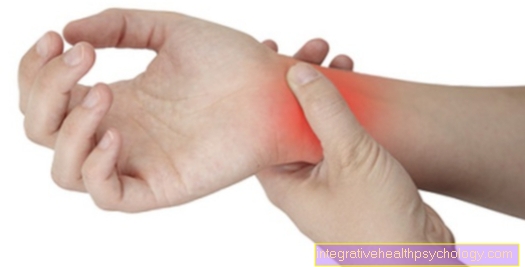vaginal pH
introduction
The normal pH value of a healthy vagina is usually between 3.8 and 4.5. So it is in the acidic range. Lower values are measured in the back of the vagina than at the entrance to the vagina. The acidic pH values of the vagina are achieved through the natural vaginal flora, which is made up of different, naturally occurring microorganisms. The so-called lactobacilli, also called lactic acid or Döderlein bacteria, make a significant contribution to the establishment and maintenance of an acidic pH value.
The normal pH value of the vagina is, however, susceptible to interference and can increase, especially if the lactic acid bacteria are reduced during antibiotic treatment, and promote the occurrence of infections.

How can you measure the pH in the vagina?
There are several methods for measuring the pH of the vagina. It is possible to have the measurement carried out by the gynecologist, who can determine the pH value with the help of a smear. In addition, a microbiological examination can be carried out in this way, if necessary, in order to determine the pathogen. This is particularly useful if the pH value is alkaline and an infection is suspected based on symptoms.
In addition, there are procedures that can be carried out independently at home. These include pH measuring strips that can be purchased in pharmacies without a prescription. These are provided with indicator paper and are inserted a few centimeters into the vagina. Upon contact with vaginal secretions, the color of the indicator paper changes and the current pH value can be read off.
PH gloves work similarly, with the indicator surface on the inside of the index finger of the glove. The index finger is inserted into the vagina with the glove on. Here, too, there is a change in color that shows the pH value.
The independent measurement can be particularly useful during pregnancy. Higher pH values indicate a bacterial vaginal infection that can lead to complications during pregnancy. Therefore, there are already some health insurances that pay for the self-measurement of the vaginal pH value during pregnancy.
What increases the pH in the vagina?
The most common reason for an increase in the pH value in the vagina is infection. Streptococci, staphylococci, Escherichia Coli and Gardnerella vaginalis, for example, can play a role.
Common symptoms of a vaginal infection are burning and itching of the vagina, often with discharge and a fishy odor. Fungi, especially Candida albicans, can also raise the pH.
The use of some antibiotics can also cause the pH of the vagina to rise. As an often accompanying and undesirable effect, not only is the actual pathogen that was the cause of the antibiotic therapy attacked, but important germs in the vaginal area also perish. By killing the lactobacilli in particular, it then comes to alkalization, i.e. an increase in the pH value.
During pregnancy, in addition to the increased likelihood of a vaginal infection, the increase in the vaginal pH can indicate premature rupture of the bladder. Since amniotic fluid has an alkaline pH value, the rupture of the bladder and contact with the acidic vaginal environment lead to a more basic pH value.
Another reason for an increase in the pH value in the vagina is the man's sperm during sexual intercourse, since the semen is naturally alkaline. It is therefore advisable to refrain from sex for a few hours before the examination if you plan to measure the vaginal pH value in order not to falsify the examination results. Urine can also raise the pH of the vagina, especially if the urine pH is alkaline from a urinary tract infection.
In addition, the vaginal pH is also influenced by the monthly cycle. During menstruation, for example, the pH rises due to blood contact and also due to a drop in the level of estrogen. Higher pH values can also be found with excessive intimate hygiene, especially if shower lotions are used that do not correspond to the natural acidic environment of the vagina. Many detergents and soaps are alkaline, which can increase the pH of the vagina. Hormonal influences also influence the value. Before menarche, i.e. the first period in adolescence, there is usually a low level of estrogen. Even after menopause, hormone levels drop again. A low level of estrogen is associated with a higher pH level in the vagina.
Read about this:
- Burning vagina - these are the causes
- Itching in the vagina
What lowers the pH in the vagina?
In addition to numerous influences that cause the pH value of the vagina to rise, there are also some factors that are able to lower it. For example, acidic urine, which, if the intimate area is insufficiently cleaned, can have a longer effect on the vaginal environment, can lead to a drop in the pH value. Urine itself has a relatively wide range of normal pH values, mainly influenced by diet, which can range between 5 and 8. The values are therefore in the acidic or basic range. As described, only acidic urine results in a lower pH value.
Furthermore, higher estrogen levels, which occur in women from the first menstrual period up to menopause with a proper hormonal balance, can lower the pH value. The external supply of estrogens, such as those used in the contraceptive pill or in the treatment of postmenopausal osteoporosis, can influence and lower the vaginal pH value.
Also read our topic: urine pH
How can I increase the pH in the vagina myself?
Numerous influencing factors play a role in lowering or increasing the pH value. Therefore, you can influence the pH value yourself through your everyday behavior.
An increase and thus a more alkaline value can be achieved when taking the anti-baby pill by discontinuing the preparation. By providing glycogen in the vaginal mucous membrane, estrogen has the effect that this is metabolized to lactic acid by lactobacilli and the pH value drops to the acidic range. Therefore, stopping the combined birth control pill leads to a decrease in the level of estrogen and thus an increase in the pH of the vagina, as this drug contains both progestin and estrogen. Progestin-only pills, on the other hand, do not affect the pH value.
Even with incorrect intimate hygiene, the use of soaps in the intimate area can increase the pH value. However, this is not to be recommended, as this massively interferes with the sensitive vaginal flora and intervenes in the natural balance and also “washes away” important bacteria. Clear water is sufficient for washing the female genital area.
Measures that serve to increase the pH value should always be taken carefully. An increased pH value in the vagina is associated with a greater risk of infections of the vagina. As a rule, a specific increase in the pH value of the vagina is therefore unnecessary.
How can I lower the pH in the vagina myself?
Particularly after antibiotic treatments and vaginal infections or a combination of both, the vaginal flora can be severely disturbed and the pH of the vagina increased. In order to restore the natural balance of bacteria in the vaginal area and to raise the pH value, the intake of lactic acids can be helpful. Special lactic acid cures from the pharmacy are suitable for this, which are usually applied over a period of seven days in the genital area. The intake of probiotic lactobacilli can also lower the pH value through their lactic acid production.
In addition, vaginal suppositories containing vitamin C can acidify the pH value and thus stimulate the growth of lactic acid bacteria.
Another possibility to intervene in the pH balance of the vagina is to take contraceptive preparations. The anti-baby pills, which contain estrogen and progestin, lower the pH value in the genital area due to the influence of the hormone estrogen. Especially during the monthly bleeding, blood contact and falling estrogen levels lead to an increase in the pH value. It can therefore be helpful to wash the genital area more frequently with clear water to remove any blood residue. Regularly changing pads and tampons while wearing air-permeable underwear can also help lower the pH of the vagina.
Is there an optimal pH?
Every body is different, so that only guidelines can be given and there is no optimal value for the vagina per se.
Values in the acidic pH range are better insofar as they are due to a higher number of lactobacilli and these fulfill an important protective function of the vagina by maintaining a stable and acidic pH value. This means that low pH values in the vagina usually indicate a good defense mechanism with regard to potential pathogens and associated infections. However, the vaginal flora of some women can be so well established that even a lower occurrence of lactic acid bacteria and thus a more basic pH value in the vagina does not necessarily mean more frequent vaginal infections.
How does the pH change with a fungal disease?
In most cases, a fungal infection of the vagina is caused by pathogens of the Candida albicans variety. These are yeasts that also need acidic pH values (approx. 4 - 6.7) for their growth, but these are somewhat more alkaline than the normal pH values in the vagina.
Therefore, as yeasts multiply in the vagina, there is an increase in the vaginal pH. This also increases with bacterial infections. A possible differentiation criterion is the fishy smell of the vagina, which is a common symptom of bacterial infections and is rather untypical for fungal infections. In addition, the discharge tends to be white and chunky, but with bacterial infections it is yellowish to greenish and has a liquid consistency.
More information on this topic: Symptoms of vaginal thrush
How does the pH value in the vagina change during pregnancy?
During pregnancy, the body is subject to strong hormonal influences and changes. As a result, an increase in the vaginal pH is more frequently observed. During pregnancy it makes sense to have the vaginal pH checked regularly and to watch out for possible changes and symptoms in the vagina that could indicate an infection. The risk of developing a vaginal infection is increased during pregnancy, and symptom-free courses are more common. Untreated vaginal infections during pregnancy carry the risk of premature labor or premature rupture of the bladder. There is also a risk of premature birth or miscarriage.
The pH of the vagina can also rise through contact with amniotic fluid. Amniotic fluid is usually slightly alkaline. If the bladder ruptures prematurely and the amniotic fluid escapes, the pH of the vagina may become alkaline. The increased discharge typical of pregnancy can also affect the vaginal pH. If the discharge is odorless and consistently colorless to slightly white in appearance, it is a completely harmless and sensible process because the vagina cleans itself.
Read more about this:
- Vaginal fungus in pregnancy
- Hormones in pregnancy
How does the pH value in the vagina change during breastfeeding?
The estrogen level is usually reduced during breastfeeding. Estrogen has a major impact on vaginal pH as the hormone helps lactic acid production by the lactobacilli by providing glycogen in the vagina. The lower estrogen level during breastfeeding leads to an increase in the vaginal pH value.
During the puerperium, the weekly flow also influences the pH value. The discharge of blood and cell components from the uterus increases the pH of the vagina. In addition, vaginal infections can occur more easily and thus also lead to an increase in the pH value.



















.jpg)









